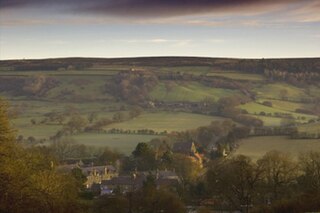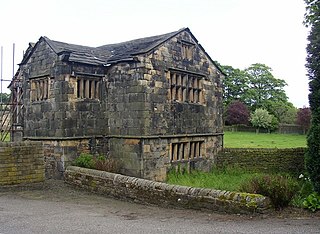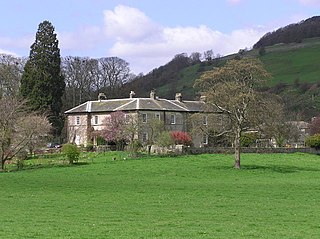
Ellerton Priory was a priory of Cistercian nuns in Swaledale in North Yorkshire, England. [1] Its ruins lie in the civil parish of Ellerton Abbey. [2]

Ellerton Priory was a priory of Cistercian nuns in Swaledale in North Yorkshire, England. [1] Its ruins lie in the civil parish of Ellerton Abbey. [2]
There is uncertainty over the establishment of the priory. It was probably founded in the late 12th century, either by the Egglescliffe family, or by Warnerus, chief steward to the Earl of Richmond, or by Wymerus of the Aske family. [3] In 1342 it suffered badly at the hands of marauding Scots, who are described as having razed and despoiled the Priory. [4]
In 1536 Thomas Cromwell's commissioners arrived to inspect the convent as part of the Dissolution of the Monasteries. The prioress Joan Harkey had to admit that one of her nuns, Cecily Swale, was asking to leave the convent. She wanted to leave after being released from her vows, but she had already given birth to a child. Not every monastery was to be closed in this phase, [5] but the priory was formally surrendered to the Crown in August that year and dissolved in the following year. The site is a scheduled Ancient Monument and parts of the priory are grade II listed. [6]
The Priory ruins stand close to the Richmond to Reeth road, just a mile downstream from the former Benedictine Priory of Marrick. [3] The ruins include the remains of the priory church built in the 15th century. The church tower appears to have been rebuilt as a romantic ruin in the 19th century. There is no public access to the ruins. [7]


Arthington Priory was an English monastery which was home to a community of nuns in Arthington, West Yorkshire, founded in the mid-12th century. The priory land is occupied by a residence called "Arthington Hall", which was built around 1585, and little, if anything, remains of the priory. The site of the priory church is possibly now occupied by a farmhouse called The Nunnery. The community was the only one of nuns of the Cluniac congregation in Yorkshire and one of two in England. It was established through a grant by Peter de Arthington.
Amesbury Abbey was a Benedictine abbey of women at Amesbury in Wiltshire, England, founded by Queen Ælfthryth in about the year 979 on what may have been the site of an earlier monastery. The abbey was dissolved in 1177 by Henry II, who founded in its place a house of the Order of Fontevraud, known as Amesbury Priory.

Rosedale Abbey is a village in the Ryedale district of North Yorkshire, England. It is approximately 8 miles (13 km) north-west of Pickering, 8 miles south-east of Castleton and within Rosedale, part of the North York Moors National Park.

Originally called the nunnery of Lekeley from the name of the land it was built upon, the former nunnery of Seaton is to the north of the parish of Bootle, Cumbria, England.

Swine Priory was a priory in the village of Swine in the East Riding of Yorkshire, England. The site of the Cistercian nunnery is a Scheduled Monument.
Alvingham Priory was a Gilbertine priory in St. Mary, Alvingham, Lincolnshire, England. The Priory, established between 1148 and 1154, was a "double house", where religious of both sexes lived in two separate monasteries. They did not commonly communicate with one another, and there was an internal wall dividing their priory church. The superior of every Gilbertine house was the prioress, the prior being really an official of her house.

Nuncotham Priory was a priory of Cistercian nuns in Brocklesby, Lincolnshire, England.
Shouldham Priory was a priory in the village of Shouldham, Norfolk, England. It was founded about 1190, and was surrendered in 1538 during the Dissolution of the Monasteries.

Marrick Priory was a Benedictine nunnery in Richmondshire, North Yorkshire, England, established between 1140 and 1160 by Roger de Aske. The parish Church of the Virgin Mary and St. Andrew and 400 acres of local land also belonged to the priory, which thrived until the 16th century, in spite of the depredations of marauding Scots.

Rosedale Priory was a priory in Rosedale Abbey, North Yorkshire, England that was founded c. 1150–1199. By the time the priory was suppressed in 1535, it had one prioress and eight nuns. The religious house in Rosedale was a priory and not an abbey, despite the village being given the name Rosedale Abbey, and it is unclear why this came about.

Farewell Priory was a Benedictine nunnery near Lichfield in Staffordshire, England. Although it received considerable episcopal support, it was always small and poor. It was dissolved in 1527 as a by-product of Cardinal Wolsey's scheme to establish a college within Oxford University.

Kirklees Priory was a Cistercian nunnery whose site is in the present-day Kirklees Park, Clifton near Brighouse, Calderdale, West Yorkshire, England. It was originally in the ancient ecclesiastical parish of Dewsbury. The priory dedicated to the Virgin Mary and St James was founded by Reiner le Fleming, Lord of the manor of Wath upon Dearne, in 1155 during the reign of Henry II.
Ellerton Abbey is a civil parish in the Richmondshire district of North Yorkshire, England. It is located on the River Swale in lower Swaledale, 6 miles (10 km) south-west of Richmond. The population of the parish was estimated at 20 in 2016. The parish consists of farmland, a few scattered houses and an area of moorland which is part of the army training area associated with Wathgill Camp. The parish includes the site of the deserted medieval village of Ellerton, not to be confused with the modern village of Ellerton-on-Swale 11 miles to the east, but there is no modern village in the civil parish.

The Keldholme Priory election dispute occurred in Yorkshire, England, in 1308. After a series of resignations by its prioresses, the establishment was in a state of turmoil, and the Archbishop of York, William Greenfield, appointed one of the nuns to lead the house. His candidate, Emma de Ebor', was deemed unacceptable by many nuns, who undermined her from the start to the extent that she resigned three months later. The archbishop, forced to find another candidate, claimed that he was unable to do so from within the priory and appointed Joan de Pykering from nearby Rosedale Priory. It is likely that Keldholme saw de Pykering as an intruder, and it seems to have reacted against her in much the same way as to her predecessor.
Joan Harkey was the last English prioress of Ellerton Priory in Swaledale in Yorkshire.
Christabel Cowper was an English Benedictine nun who was the last prioress of Marrick Priory before the Dissolution of the Monasteries.

Ellerton AbbeyHouse is an historic building and estate in Ellerton Abbey, North Yorkshire, England. It was built around 1830 for the Fore Erle-Drax family, and has been designated a Grade II listed building by Historic England. The property is located at the end of a long driveway off the northern side of the B6270 Richmond Road, about 450 feet (140 m) southwest of Ellerton Priory, now ruined.